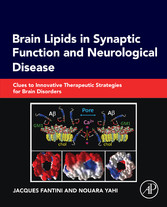Suchen und Finden
Brain Lipids in Synaptic Function and Neurological Disease - Clues to Innovative Therapeutic Strategies for Brain Disorders
Mehr zum Inhalt

Brain Lipids in Synaptic Function and Neurological Disease - Clues to Innovative Therapeutic Strategies for Brain Disorders
Lipids are the most abundant organic compounds found in the brain, accounting for up to 50% of its dry weight. The brain lipidome includes several thousands of distinct biochemical structures whose expression may greatly vary according to age, gender, brain region, cell type, as well as subcellular localization. In synaptic membranes, brain lipids specifically interact with neurotransmitter receptors and control their activity. Moreover, brain lipids play a key role in the generation and neurotoxicity of amyloidogenic proteins involved in the pathophysiology of neurological diseases. The aim of this book is to provide for the first time a comprehensive overview of brain lipid structures, and to explain the roles of these lipids in synaptic function, and in neurodegenerative diseases, including Alzheimer's, Creutzfeldt-Jakob's and Parkinson's. To conclude the book, the authors present new ideas that can drive innovative therapeutic strategies based on the knowledge of the role of lipids in brain disorders.
- Written to provide a 'hands-on' approach for readers
- Biochemical structures explained with molecular models, and molecular mechanisms explained with simple drawings
- Step-by-step guide to memorize and draw lipid structures
- Each chapter features a content summary, up-to-date references for additional study, and a key experiment with an explanation of the technique
Jacques Fantini was born in France in 1960. He has over 30 years of teaching and research experience in biochemistry and neurochemistry areas. Since 1998, he is professor of biochemistry and honorary member of the 'Institut Universitaire de France'. He has demonstrated the implication of glycolipids in the attachment and fusion of HIV-1 with the plasma membrane of target cells, and has published several important articles in this field. He is an active member of the research group 'Molecular Interactions in Model and Biological Membrane Systems' led by Nouara Yahi. This group is internationally recognized for studies of lipid-lipid and lipid-protein interactions pertaining to virus fusion, amyloid aggregation, oligomerization and pore formation. Together with Nouara Yahi, Jacques Fantini has discovered the universal sphingolipid-binding domain (SBD) in proteins with no sequence homology but sharing common structural features mediating sphingolipid recognition. The SBD is present in a broad range of infectious and amyloid proteins, revealing common mechanisms of pathogenesis in viral and bacterial brain infections, and in neurodegenerative diseases. His current research is focused on the molecular organization of the synapse in physiological and pathological conditions. Jacques Fantini is the author/co-author of 167 articles (PubMed), with 5800 citations and a H-index of 42. He has also published 4 patent applications.
Alle Preise verstehen sich inklusive der gesetzlichen MwSt.












